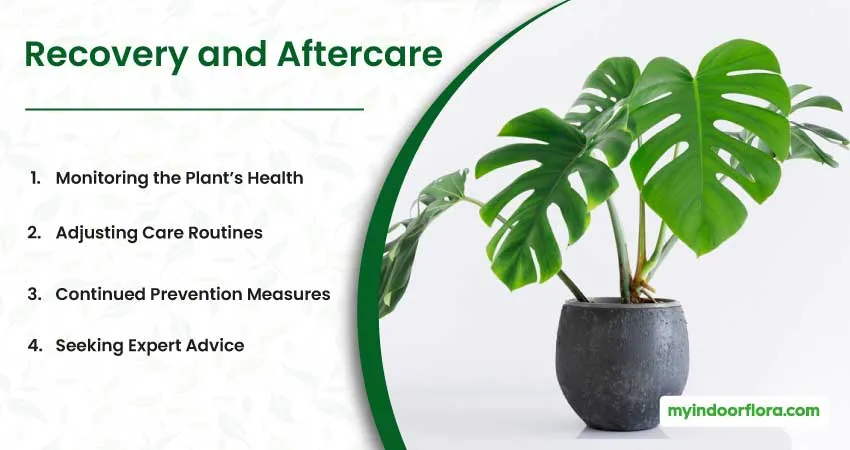Monstera plants are popular for their striking foliage and unique aesthetic. They can be found in homes, offices, and gardens, bringing a touch of the tropics to any space. As a monstera caretaker, you may encounter issues like rust fungus which can cause brown spots or raised bumps on the leaves. Understanding the causes and treatments for such problems will help keep your monstera plants healthy and thriving.
In this article, we will explore potential causes of rust fungus on monstera plants and discuss effective solutions to address them. By identifying the signs of rust fungus and implementing the appropriate treatments, you can maintain the health and beauty of your monstera plants for years to come.
What Does Rust Fungus Look Like
Rust fungus, as the name suggests, often appears as rust-colored spots or patches on the leaves of the Monstera plant. However, the identification process requires a more detailed examination.
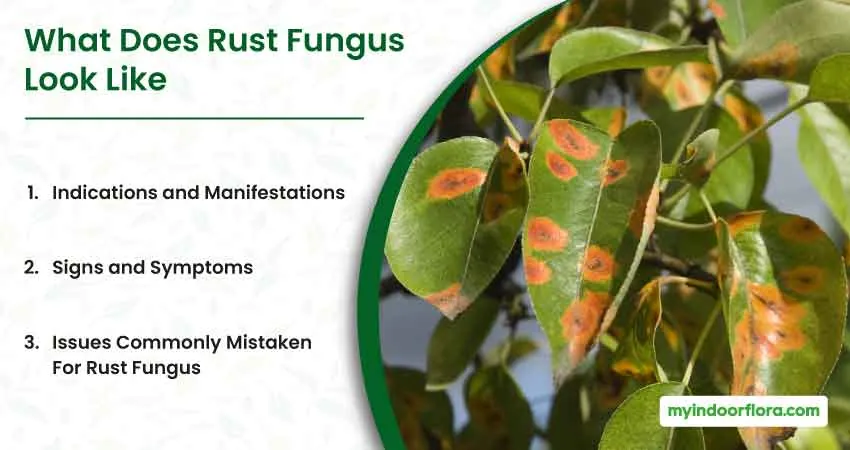
Indications and Manifestations
When examining your Monstera, be attentive to the possibility of rust fungus. Often, it manifests as small orange-red spots on the leaves, which can be raised or indented and may have a powdery texture. In more severe cases, these spots can merge, forming large rust-colored areas.
The fungus can also reach the plant’s stems, causing them to turn orange or red. Keep in mind that the fungus may also produce red or black spots on the leaves, eventually covering the entire leaf if left untreated. It typically first appears on the underside of leaves where moisture accumulates and in areas with less air circulation, such as where a leaf stem joins the main stem or behind larger leaves.
Signs and Symptoms
If your Monstera plant starts to exhibit orange or brown spots on the leaves, it may be dealing with rust fungus. This common issue can affect various plants, but luckily, it’s relatively simple to treat. Some usual symptoms of rust fungus entail:
- Small, orange or brown spots on the leaves
- Yellowed or discolored leaves
- Stunted or unhealthy-looking plant
- Impaired flower development
- Severe infections can cause the leaves to weaken, yellow, and eventually drop off.
For those who want a definitive diagnosis, examining a leaf sample under a microscope can reveal the presence of rust spores. These spores are typically oval and rust-colored.
Issues Commonly Mistaken For Rust Fungus
There are several problems that can resemble rust fungus on Monstera plants, making it essential to differentiate between them for proper treatment. Listed below are some common issues often mistaken for rust fungus:
- Powdery mildew: This type of fungi manifests as a white, powdery substance on plant leaves and can cause discoloration and stunted growth. However, unlike rust fungus, it doesn’t usually result in rust-colored powder or brown-orange spots on leaves or stems.
- Bacterial leaf spot: This plant disease also causes yellow or brown spots on leaves, much like rust fungus. The key difference lies in the additional presence of dead patches or holes in the leaves due to bacterial leaf spot.
- Fertilizer burn: When you’re new to gardening, it’s easy to use too much fertilizer, leading to fertilizer burn. This issue presents as brown or yellow spots on plant leaves, similar to rust fungus. However, fertilizer burn typically affects the leaf edges, while rust fungus impacts the entire leaf.
Keep in mind these distinctions when you encounter issues with your Monstera plants, as each problem requires a different approach to treatment.
6 Causes of Rust Fungus
Understanding the root causes of rust fungus is paramount in its prevention and treatment.
1. Excessive Watering
Excessive watering can lead to an increase in moisture levels, providing an ideal environment for rust fungus to thrive. To address this, ensure the soil dries out between waterings and monitor the soil moisture using a moisture meter or the finger test.
2. Inadequate Light
If your Monstera is not receiving enough light, it becomes vulnerable to rust fungus. Address this issue by moving your plant to a brighter spot and providing it with ample indirect sunlight when possible. Be mindful of the watering frequency under these conditions.
3. High Humidity Levels
High humidity can contribute to the growth of rust fungus. Use a small fan or dehumidifier to control the humidity around your plant, and monitor the levels using a humidity meter.
4. Insufficient Air Flow
Poor air circulation can also lead to the development of rust fungus on your Monstera plant. Enhance air circulation by placing a fan nearby or opening windows to allow natural air flow on temperate days.
5. Unclean Tools
Using unsanitized tools when pruning or repotting your Monstera increases the risk of rust fungus development. Always use clean, sharp tools and disinfect them between uses.
6. Contamination from Other Plants
Rust fungus can be transferred between plants through physical contact. Prevent contamination by keeping your Monstera in a well-ventilated area with controlled humidity levels. Quarantine any infected plants and remove affected leaves, treating the plant with a suitable fungicide or bactericide as necessary.
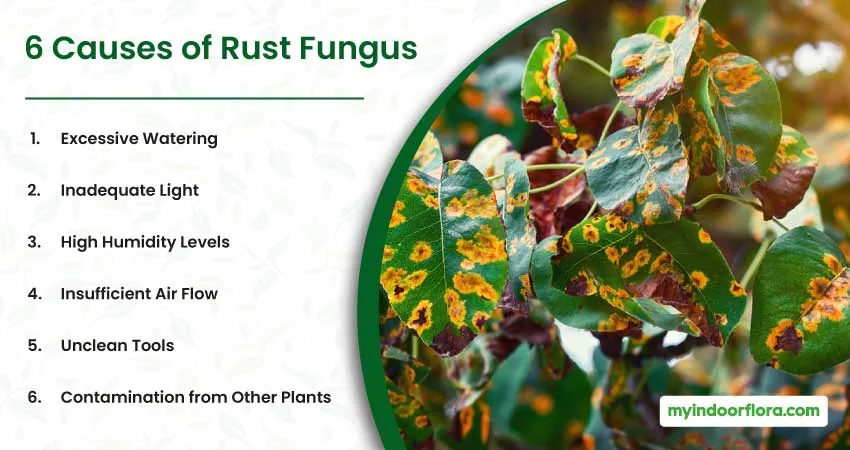
Prevention Strategies for Rust Fungus
Preventing rust fungus is pivotal for maintaining the health and beauty of your Monstera plant. Here’s a comprehensive approach.
1. Opt for Rust Resistant Varieties
When selecting plants for your home, be sure to inquire about their resistance to rust fungus and other diseases at your nursery or garden center. While not many plants are naturally resistant to fungi, doing some additional research or consulting local nurseries about rust-resistant plants might be helpful.
Boosting your Monstera’s immunity to rust can be achieved by keeping it fertilized and providing it with a root supplement that helps combat fungi or diseases before they infect your plant.
2. Choose Rust-Free Plants at Purchase
Preventing rust fungus is essential, so it’s important to select rust-free plants when purchasing and to remain vigilant in checking your plants for early signs of infection. When buying plants from a nursery or garden center, carefully inspect them before making your purchase.
Look for any orange or brown spots on the leaves, stem, or flowers, as these are indicators the plant may be infected with rust fungus. If you notice any suspicious spots, it’s best to play it safe and choose a different plant.
Once rust takes hold, it can be challenging to eliminate. Therefore, starting with a healthy plant without any signs of infection is always the better option.
3. Proper Watering Techniques
Ensuring the top 2 inches of soil are dry before watering can prevent overwatering. It’s not just about the amount but also the frequency. Watering from the bottom, by placing the pot in a tray of water, can reduce the chances of leaf moisture, which can lead to fungal growth.
4. Soil Selection and Potting
Opt for a well-draining potting mix. Adding elements like perlite, sand, or orchid bark can enhance drainage. Terra cotta pots can help wick away excess moisture, and it’s essential to ensure pots have adequate drainage holes.
5. Environmental Control
Maintaining a humidity range of 40-60% is ideal for Monsteras. In areas with high humidity, dehumidifiers can be beneficial. A gentle fan can improve air circulation, and it’s crucial to ensure plants aren’t too close together.
6. Regular Inspection and Quarantine
Regularly inspect your Monstera for signs of rust fungus. Keeping new plants separate for 2-4 weeks can ensure they don’t introduce any diseases.
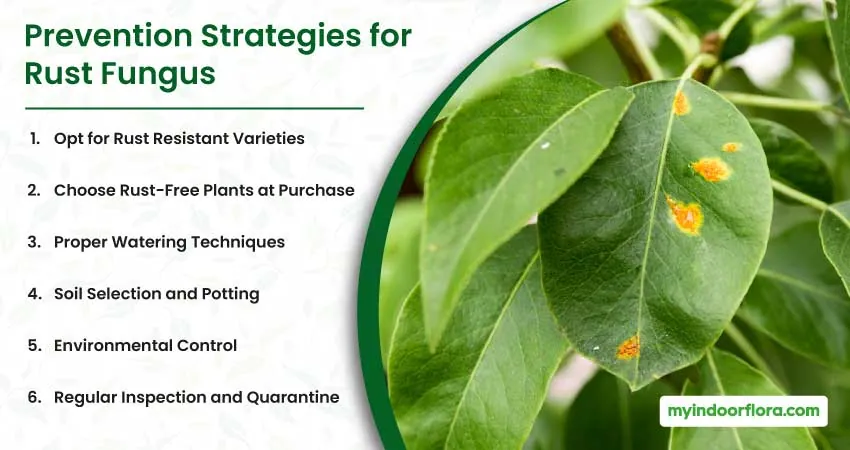
Rust Fungus Treatment
If your Monstera becomes infected, here’s how to address it:
1. Isolating Infected Plants
Immediately upon identifying rust fungus on your plant, separate it from other houseplants to prevent the disease from spreading.
2. Cutting Off Diseased Leaves and Stems
Thoroughly inspect your plant for any signs of rust fungus, which can vary in size. Utilize sanitized pruning shears to remove affected leaves and cut off infected stems below the problematic area. Make sure to leave some nodes to ensure continuous growth after recovery. If necessary, gradually prune your plant every four to five days to avoid shock and balance fungus removal. For minor infestations with few spots, consider applying neem oil.
3. Applying Neem Oil
After discarding infected leaves and stems, use neem oil, a natural agent against rust fungus. Combine one part neem oil with two parts water and spray it on the plant, including leaf undersides. Let the mixture sit for at least six hours before rinsing off with water. Repeat the process every few days until the fungus disappears.
4. Employing Household Remedies for Rust Fungus
Several home remedies can help eliminate rust fungus. Mixing equal parts of baking soda and water into a paste and applying it to affected areas may provide relief.
Alternatively, combine one part bleach with nine parts water to create a soak or spray solution. Some also recommend using a mixture of one part vinegar and five parts water, allowing it to dry on the leaves before washing off. Make sure to thoroughly rinse your plant after all treatments, as prolonged exposure may cause further damage.
5. Utilizing Fungicides
Fungicides are a common solution for rust fungus, as they target the responsible fungi. Select a fungicide specifically designed for rust fungus and follow the manufacturer’s guidelines for application.
Remember that fungicides kill fungi but won’t cure already-infected plants, so it’s best to provide optimal growing conditions to prevent rust fungus from developing in the first place.
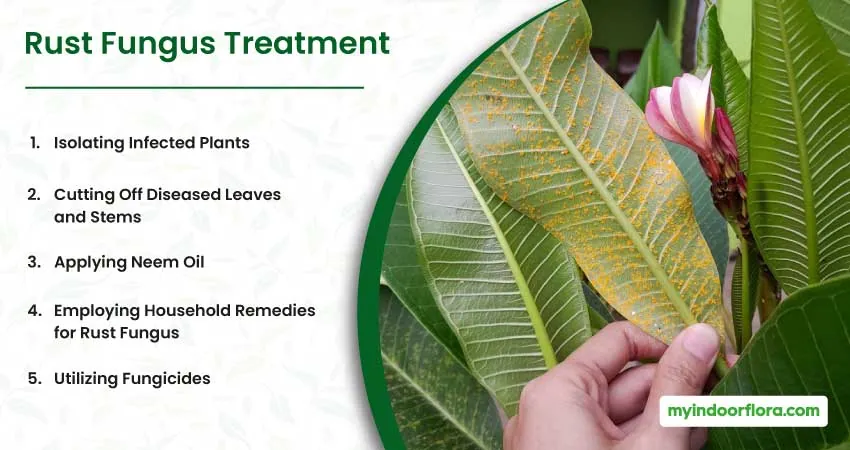
Recovery and Aftercare
Once you’ve treated your Monstera for rust fungus, the journey isn’t over. The recovery phase is crucial, and proper aftercare ensures that the plant not only survives but thrives.
Monitoring the Plant’s Health
Observation: Regularly inspect your Monstera’s leaves and stems. Look for new growth, which is a positive sign, but also keep an eye out for any recurrence of rust spots or other symptoms.
Growth Patterns: A healthy Monstera will display vibrant green leaves, and over time, you should notice new leaves unfurling. The rate of growth can be an indicator of the plant’s overall health.
Adjusting Care Routines
Watering: Post-treatment, it’s essential to be even more vigilant about your watering routine. Ensure the soil is dry before watering, and avoid letting the plant sit in water.
Light: Ensure your Monstera receives adequate indirect sunlight. Too little light can weaken the plant, making it more susceptible to diseases.
Feeding: After a rust fungus infection, your Monstera might benefit from a balanced, water-soluble fertilizer to boost its recovery. However, avoid over-fertilizing, which can stress the plant.
Continued Prevention Measures
Environmental Adjustments: If humidity was a contributing factor to the rust fungus, consider using a dehumidifier or placing a fan near the plant to improve air circulation.
Soil Checks: Even after treatment, it’s a good idea to occasionally check the soil’s pH and moisture levels. This can help you catch any unfavorable conditions before they become problematic.
Regular Pruning: Removing dead or unhealthy leaves can promote better growth and reduce the chances of future infections. Always use sterilized tools to prevent the spread of pathogens.
Seeking Expert Advice
Join Plant Communities: Platforms like online forums, social media groups, or local gardening clubs can be invaluable. Sharing your experience and learning from others can provide additional insights into Monstera care.
Consult with Botanists or Plant Pathologists: If you’re struggling with recurrent issues or need expert advice, consider reaching out to professionals in the field. They can offer guidance tailored to your specific situation.
